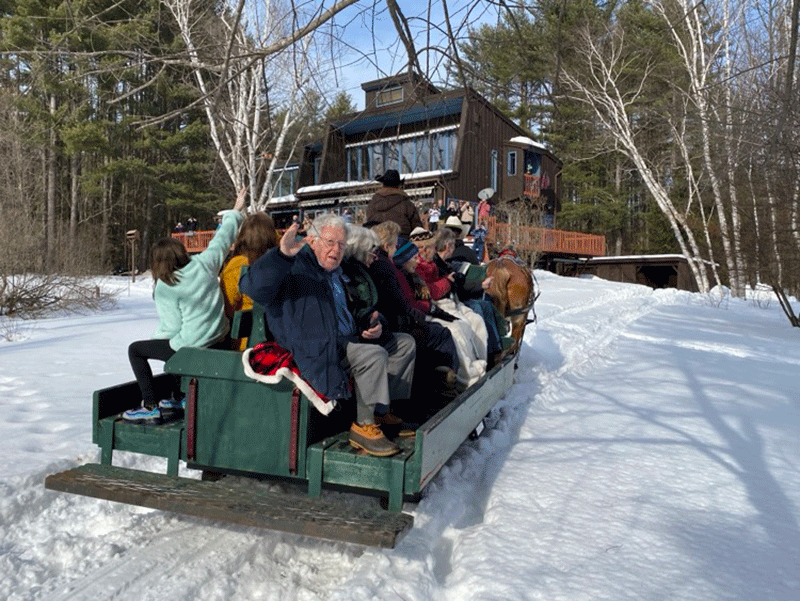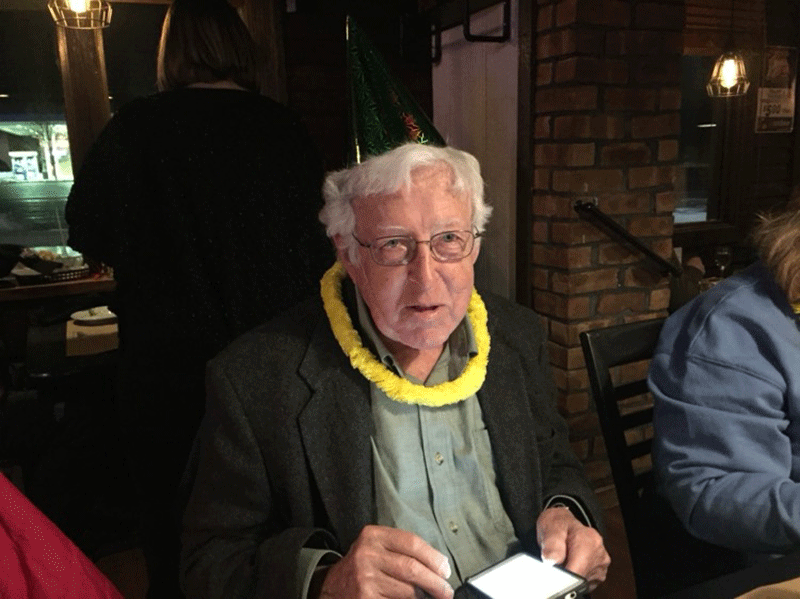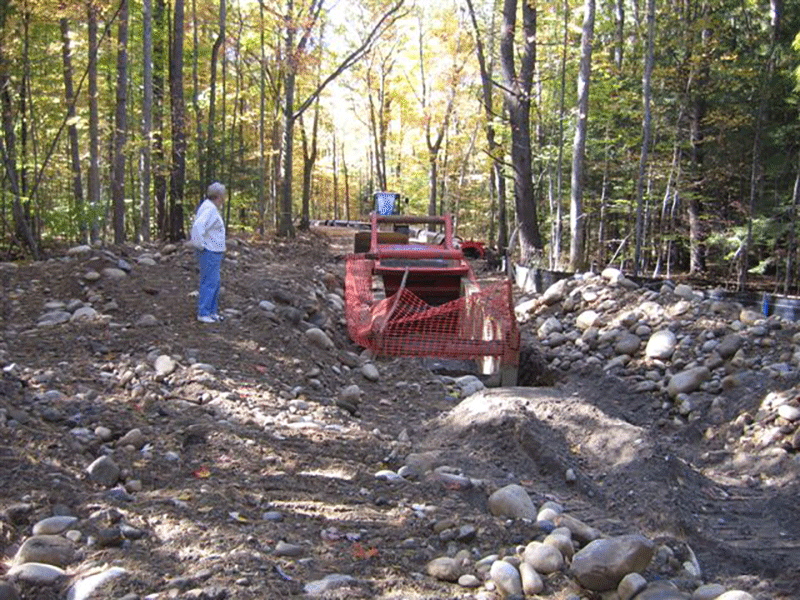Charlie Morrison was one of the founding Directors of Protect the Adirondacks. He was passionate about protecting the Adirondack Park and dedicated his career to environmental planning, management, and protection. He helped to guide the early days of Protect the Adirondacks as he urged us to have an acute focus on Article 14, Section 1, the Forever Wild clause of the State constitution. Charlie was a force who charmed and bonded with everybody on the Board of Directors and on the Conservation Advocacy Committee. Charlie passed away in January, in his 96th year surrounded by his children. He lived a long life where he focused on his family, protecting the environment, and working on many civic projects and causes in Saratoga Springs, where he lived for over 50 years. Charlie married his wife Marie in 1958 and they were married for 52 years, until her passing in 2010.
Charlie was born in 1928 and grew up in northern New Jersey and started exploring Upstate New York in the years he attended Colgate University. He received a master’s degree from Columbia and started work with the American Geographical Society, studying glaciers in Alaska, Canada, and the Rockies. From there he went to Washington DC, where he worked under Interior Secretary Stewart Udall in the newly formed Bureau of Outdoor Recreation, and with the Recreation Resources Review Commission, chaired by Laurance Rockefeller, where he helped develop reports that led to the creation of the Land and Water Conservation Fund and the Wild and Scenic Rivers Act.
In the late 1960s, he followed his colleague at the federal Bureau of Outdoor Recreation, Henry Diamond, to New York State, where Charlie became the Director of the newly formed Commission on Natural Beauty, reporting directly to Governor Nelson Rockefeller. During this time, Charlie worked with Governor Rockefeller’s Temporary Study Commission of the Adirondacks, touring mining operations in the Adirondacks.
In 1970, Charlie joined the newly established Department of Environmental Conservation (DEC), where Diamond was the first Commissioner. He became Director of Land Resources Planning at the DEC and was a key player in the State’s Scenic Byways program, which brought federal money to improve scenic roads in the State, and in many significant land protection efforts. His long career at the DEC saw him active in planning for Lake George, Forest Preserve management, and helping to establish the Champlain-Adirondack Biosphere Reserve designated by UNESCO globally recognized landscape.
While he had spent many years in various state federal and state environmental agencies, Charlie also saw the importance of an energized public and independent environmental advocacy. Charlie began his involvement with Sierra Club Atlantic Chapter Conservation Committee and Adirondack Committee in the 1970s as an important “behind-the- scenes” player. Upon his retirement from state government, Charlie became a leader of the Sierra Club in Albany. “Calls from Charlie often came out of the blue; but when you got one you knew it was going to be a substantive issue about the Adirondack Park, and that you’d better do your homework on in a hurry so you could keep up with him,” said Roger Gray, Sierra Club Adirondack Committee. “Charlie was the heart and soul of the Club’s Adirondack Committee.” He helped to form the Environmental Planning Lobby, which today is Environmental Advocates. He also became active with the Association for the Protection of the Adirondacks, which was one of the groups that merged to form Protect the Adirondacks.
Charlie’s knowledge of the Adirondack Park was encyclopedic. Lorraine Duvall, a well-known Adirondack writer and PROTECT Board member, recalled leaning on Charlie for his knowledge of dams in the Adirondacks. She once wrote him an email about dams on the Hudson River when she was working on a book about canoeing. Here’s how Charlie responded:
Lorraine:
There are at present several dams along the tributaries of the Upper Hudson River that we almost take for granted. There is the present Indian Lake Dam constructed in 1898. But there were two-predecessor lumberman’s dams one constructed c.1845, and the other constructed in the 1860’s by Finch Pruyn Co. The length of Indian Lake in the 1860’s was a little over three miles. But after the 1898 dam (present dam) the length of Indian Lake grew to thirteen miles. There is also the Lake Adirondack Dam originally begun in 1909 and then reconstructed in 1937-1938 by the Works Progress Administration. There is also the Lake Abanakee Dam constructed in 1951.
The Indian Lake dam is a DEC dam on Forest Preserve land, built in 1898 by the Indian River Company, a consortium of lumber companies. The dam is operated by the HRRRD – how that happened is one of the illegal things which you don’t want details on. There also is no agreement between the HRBRRD and DEC to delegate operational authority and there is no agreement as to the operating regime between DEC and HRBRRD.
The pulsing regime being followed by the HRBRRD in operating the dam to refill Lake Abanakee in order that the Town can release 2-hour slugs of water for the rafting is in violation of the WSRR System Act which requires natural flows for designated rivers under APA rules for designated rivers on the private land between Indian Lake Dam and Lake Abanakee.The 1951 Lake Abanakee Dam is owned and operated by the Town primarily to facilitate the rafting, which as already mentioned requires the cooperation of HRBRRD in making timed releases from Indian Lake Dam.
Further, the area below Abanakee Dam is all Forest Preserve on both sides of the river, a designated WSRR flowing into the Hudson, a Wild River. Again, multiple violations of the WSRR Act.DEC has issued a permit to the Town to allow it to issue, in turn, permits to individual rafting companies. Last I looked the DEC “annual permit to the Town” was years out of date. Also, apart from WSRR violations, the Town and DEC have been letting rafting companies camp in the Hudson River Gorge. (I presume this is still going on.)
That’s the short version.
At Protect the Adirondacks, Charlie was one of a group of volunteers that lead the organization in its first years, when he anchored the Executive Committee. He helped to build-up the Conservation Advocacy Committee, which sets policy for the organization.
Charlie was also a citizen activist in Saratoga Springs, working on its conservation committee to protect wetlands in the area, to expand Saratoga Spa State Park, to address problems with the city’s water supply, and its planning program for its overall development. Charlie was gregarious and generous with his time. Jim Dawson, a PROTECT Board member and Professor of Geology at SUNY Plattsburgh, recalled how generous Charlie was with his time when Charlie not only mentored Jim’s students from SUNY Plattsburgh during their internships with Lands and Forests at NYSDEC, but how he also kept in touch with these students after their college graduation and well on into the early years of their professional careers.”
One of his greatest environmental achievements was his years of work, in collaboration with the Pace University Law School, and Sierra Club activists, securing public rights to navigation on waterways in the Adirondacks, which resulted in a December 17, 1998, New York State Court of Appeals ruling that that the usefulness of a stream for recreational travel, not just traditional commercial use, must be considered in deciding whether a stream is “navigable-in-fact”, and which opened the Moose River in the Adirondacks to paddlers. Charlie worked for years after the 1998 Court decision to get a list of navigable rivers established in regulation so that each river need not be individually tried in the courts.
“Charlie knew the right time and place to remind officials of their duty to act, both in his service in government and in his civic leadership outside of government. Some thanked him, and there were also those who felt that he had rubbed them the wrong way, but none could ignore Charlie’s call to conscience,” wrote Professor Nick Robinson, Pace University School of Law emeritus, and Sierra Club Honorary Vice President.
In his later years, Charlie spent winters in the Florida Keys, where he had lots of friends and swam in the ocean almost daily, and he enjoyed taking the train down to New York City to visit his adult grandchildren when they were living there. When he was 93, Charlie moved west to Seattle, leaving his long-time home in Saratoga Springs, to live where his children were. His family was able to spend a lot of time with him during his last years.








